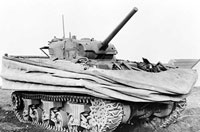DD Tank

Based on the standard American M4 Sherman medium tank, the DD tank, so named for its "duplex drive," was modified to allow the vehicle to travel on water as well as land. British Major General Percy Hobart, tasked with creating specialized tanks (often known as "Hobart's Funnies") to cope with German defenses, used a design originally conceived in 1941 by Nicholas Straussler and successfully used on Valentine and Tetrarch tanks.
Propulsion in the water was achieved by a pair of propeller screws which could move the tank at a speed of 4 knots. Navigation was accomplished by moving the propellers in conjunction with a simplified rudder/tiller arrangement on the rear of the tank.
Flotation was provided by thirty-six rubber air tubes/pillars. The tubes were attached to a collapsible canvas screen which, once air was pumped into the system via a pneumatic pressure system, would expand to provide the necessary buoyancy. The screen itself was attached to a boat-shaped metal framework welded to the tank's hull. This system could be inflated in 15 minutes, and could be quickly deflated when the tank reached a depth of 5 feet or less. Once the screen was deflated the tank had full use of its turret and could operate as a normal tank.
The DD tank was used by ten tank battalions of British, Canadian and American forces during the Normandy landings on June 6th, 1944. Although the design was generally considered to be a success, many of the tanks that were assigned to Omaha Beach that launched from out at sea (6,000 yards out) foundered and sank in the choppy channel waters.
741st Tank Battalion
Thirty-two DD tanks from Company B and Company C (16 per company) were intended to support the 1st Infantry Division at Easy Red, Fox Green and Fox Red sectors. Of the 29 DD tanks that were launched only 2 made it to the beach. Three others were taken directly to the beach.
| Tanks | Notes | |
|---|---|---|
| LCT-537 | 4 | All launched. |
| LCT-599 | 4 | All launched. |
| LCT-600 | 4 | Only 1 tank launched, which sank. Other 3 landed directly on the beach. |
| LCT-603 | 4 | All launched. |
| Tanks | Notes | |
|---|---|---|
| LCT-549 | 4 | All launched. All 4 sank. |
| LCT-598 | 4 | All launched. All 4 sank. |
| LCT-601 | 4 | All launched. All 4 sank. |
| LCT-602 | 4 | All launched. All 4 sank. |
743rd Tank Battalion
Seeing how choppy the channel waters were, the LCTs carrying the 743rd Tank Battalion brought their DD tanks to shore and landed them directly on the beach around 6:40 a.m. Four of Company B's tanks were quickly destroyed when their LCT was sunk by an artillery shell just as it hit the beach.
| Tanks | Notes | |
|---|---|---|
| LCT-535 | 4 | Landed on beach. |
| LCT-586 | 4 | Landed on beach. |
| LCT-587 | 4 | Landed on beach. |
| LCT-589 | 4 | Landed on beach. |
| Tanks | Notes | |
|---|---|---|
| LCT-588 | 4 | Landed on beach. |
| LCT-590 | 4 | Landed on beach. |
| LCT-591 | 4 | Landed on beach. |
| LCT-713 | 4 | Landed on beach. |
The 741st and 743rd Tank Battalions also landed various LCT(A)'s that carried two waterproofed M4 Sherman tanks and a tank dozer each.
Fact vs. Fiction
Captain Miller's comment that "all of the armor is foundering in the channel" was not correct in regards to his sector of the beach. Tanks of the 743rd Tank Battalion were able to land around Dog Green Sector, but those that made it ashore quickly became prime targets for the Germans. Miller's comments would have been quite appropriate to describe the 741st Tank Battalions lack of success, but he should not have been aware of what was happening on the other side of Omaha Beach.
Lt. Col Anderson makes mention of expecting 32 tanks on the beach, but indicates that 27 were lost. Assuming that he is talking about the 741st Tank Battalion, those numbers aren't quite accurate. Furthermore, he appears to be talking to someone about offloading some DD Tanks on the beach that are needed for a combat operation. This scene occurs on D+3, which is June 9th. DD Tanks were designed solely for the initial assault on June 6th, so it wouldn't make sense for any of them to be hitting the beaches three days after D-Day.
